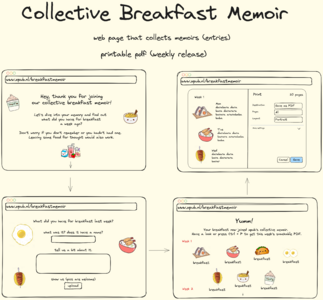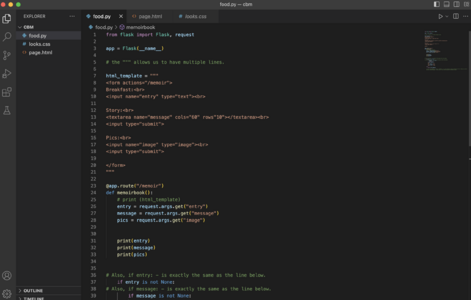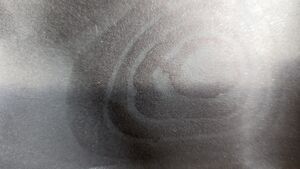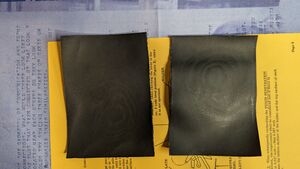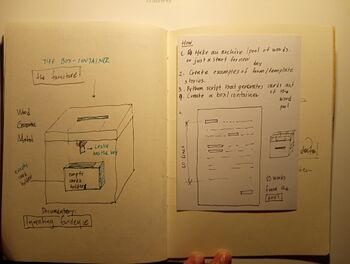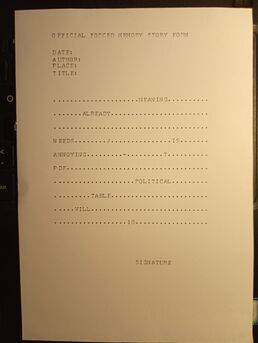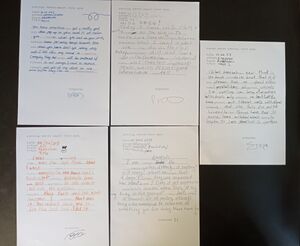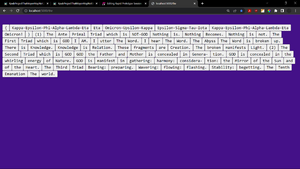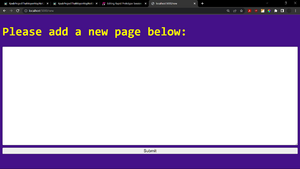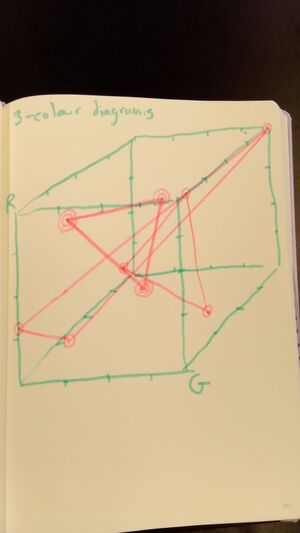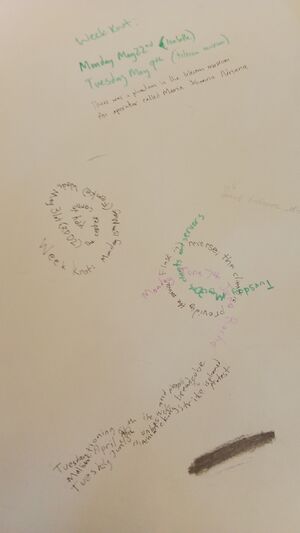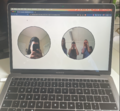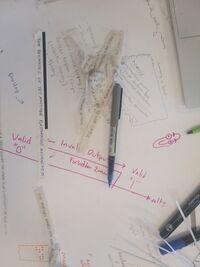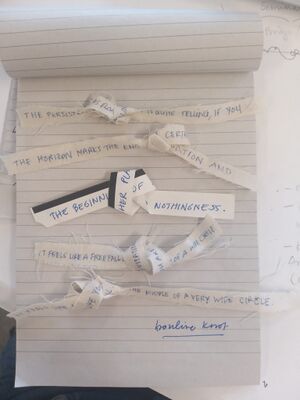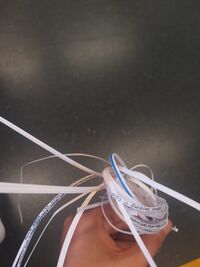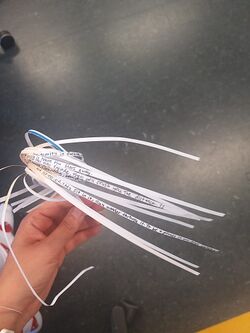Rapid Prototype Session 2
Projects that MAY or MAY KNOT be made
Boyana
CBM
What?
Collective Breakfast Memoir: a (snackable) publication about breakfasts people had in the last week. Why do you want to make it? (Three sentences max)
Why Make it?
To work with memory as a tool that evokes memories of taste and/or instances of conversations around food people (participants) had recently.
Workflow
Simple web page where participants can make an entry of their weekly breakfasts (in case they hadn't had breakfast they'd be invited to share some food for thought). Paged.js will help us turn all web entries into a printable publication.
Timetable
1 day build the website:
- html structure - flask? form for input (text, (+ optional) images) - css, style the webpage - paged.js, turn web content into printable pdf
1h share the website with people and invite them to join 1 week collect stories 1h design book cover? 2h print the publication 2-3h share + send the printed publications to participants (and not only) turn it into weekly release?
Rapid prototypes
SoS
What?
Audio piece made by a group of people.
1. Imagine yourself (or your entire body) as a walking auditory organ, like a human ear, that examines the sound of silence. The "ear' listens to the surrounding environment. The ear is deaf to noise and can only hear (resonate with) silent situations, whatever that could be.
2. Record an audio piece that is a collection of various sounds
3. recorded or sent by me and other participants
4. I write a short poem (haiku, or 3-5 lines at max) that describes the soundscape depicted in the audio piece.
Why make it?
I am often inspired by listening. The project is about the act of improvising; I wanted to combine sound and poetry. Presents a method for sound mixing and writing. It is an Invitation for people to join and collaborate on this silent exploration of our daily situations. The act of improvising, the act of composing poetry or music extemporaneously.
Workflow
1: Write an invitation for participation and invite people to join by distributing it both print & web.
2: Spend some time recording sounds and collecting sounds from others.
3: Save and listen to all sounds and think of was to combine all of them into one.
4: Once we have the audio piece then we can write a short poem about it. What feelings, scenery and/or emotions it evokes in us? A moment of reflection, turning sounds into words.
Timetable
30 min writing the invitation and giving people the option to receive the sound + audio piece if they want
1h printing/distributing the invitation
1 week collecting sounds
1 day listening to all sounds
2-3 hours curating and combining all sounds into one piece
1 hour writing a short poem about it
NewStream
What?
NewStream is a serial, print and/or non-print publication issued in parts, expected to continue indefinitely. Each issue contains fiction stories about ‘newsworthy’ events told as if humans were able to listen and understand what oceans, seas, lakes, rivers, and dams speak about. Authors of the stories imagine themselves as if they were water and write from this mode of address.
Why Make it?
I was triggered by the news about the dam in southern Ukraine that has been destroyed, unleashing a flood, corps, chemicals and mines going into the Black Sea. I felt very bad about it and it made me wonder, what if the water could speak to us, what kind of news would tell us, what would a news stream look like then, what would the events water would share, who’s the reader, and more…
Workflow
NewStream gives space to everyone who would like to share a story from the water’s perspective, to empathise with water. People who want to join could do so via a website, email, and/or by sending a letter. Then, all stories will be collected, read, curated, and formatted according to the chosen form of the coming issue, whether a print or web publication, film, installation, etc.
+ method: suminagashi scratches (aka ebru, paper marbling) to make a companion gallery for each story, visuals are never the same, water and ink form different shapes and patterns
suminagashi x scratches
- think of a continent. open a map and choose a source of surface water. imagine you’re water and ask yourself: where am I? what surrounds me? what is happening around me? how does this make me feel? what are the first thoughts that come to my mind? do I feel trapped? do I feel used? do I feel at ease with what’s happening? does something happen to me? answer those questions by writing about them in no more than 20 minutes.
- think of a continent. open a map and choose a source of groundwater. imagine you’re water and ask yourself: where am I? what am I seeing here? what are my surroundings? do I contain something or am I the one that is the content? what are the issues I am faced with? do I get any help? how do these issues make me feel? what are the first thoughts that come to my mind? do I feel trapped? do I feel used? do I feel at ease with what’s happening? does something happen to me? answer one question a day by writing about it. spend no more than 10 min on each question.
- think of an ocean. open a map and choose an area within the ocean you chose. imagine you’re water and ask yourself: where am I? what am I seeing here? what are my surroundings? do I connect things? do I keep things apart? are there any living things around you? are there any dead things around you? what thoughts do these things bring about? answer those questions in no more than 10 lines.
+ technology: various, depending on the chosen format (for example software, cameras, printers, speakers…)
Timetable
- open call: an invitation to writers or whoever feels like writing in the suggested mode of address
- writing a story: stories could be long and short-form text, poems, etc.
- collecting other’s stories
- reading and curating submitted stories: deciding what goes into the coming issue)
- formatting; release form is fluid, it changes and shapes constantly
- publishing/release moment
- repeat: prepare the next one
Prototype:
Story, following scratch #3 | mode of address example:
humans tend to identify me as a sea but that’s not the way I see myself. they also gave me a name, many names actually. today, I’ll go by the Black Sea. some say that the name comes from the dark color of my waters or climatic conditions. I guess that’s easier for them, calling things in a certain way. the same goes for the ‘states’ that surround me, all 6 of them. but in the end, it’s just land. I feel quite blue these days, to be honest. angry and in grief too. corps, chemicals and mines are poured into me. but i am not an endless drainage basin of Europe. i can’t handle it any more. just wanted to share it with someone. thank you for listening.
Broken?
What?
Monthly collaborative and exploratory sessions during which participants will use the kintsugi technique to repair broken pottery while discussing (collective) trauma and self-healing practices. Groups will be kept small and cosy, with a maximum of 10 participants. The first meeting, kintsugi, was in February 2023. No recordings, no writing, no documentation. The release moment (the publication itself) is the session. The only trace of the event is the memory of people attending.
Why Make it?
To make space for strangers to have an open conversation around difficult topics. It’s a workshop-like collaboration yet also an exploratory discussion so everyone who’s joining is encouraged to bring their own thoughts and experiences to the conversation. Multiple sessions can happen simultaneously and in groups that speak the same (not necessarily) language, including sign language.
Workflow
+ method: rapid prototypes (what-why-how-who) + technology: pottery and other broken objects? kintsugi kit?
- plan and organise the session: what, where, & when is happening
- communication: make print and web materials to inform people about the session
- send invites + put posters around the city
- prepare for the event: materials, thoughts and experiences to put on the table
- event: share the moment with others, listen, empathise, talk (if you feel like it), and just be there
- repeat
Timetable
- 2-3 days for preparing the communication materials
- 2 weeks to communicate and invite people to join
- 1 week preparing for the event
- 1 day for the event itself
- 2-3 days follow-up communication with participants
- 2-3 for reflection, what went good and what can be improved, changed
Aglaia
Title: It doesn’t have to be good but to exist
What is it? Elements= Forced Memory Cards ( a5) which contains lines on which to write memories and prompts for the user, memory locked box (Leslie will be the key holder), the members and tutors of Xpub1.
Procedure:
1. Fill in the memory form.
2. Deposit memory form in the box (like a locked polling box with a slit at the top)
3. At an agreed date (in one year; in one month; one week later) the box is opened and a publication is made from the collection of memories (forced story forms).
It will be a forced memory box with a lock with a stack of potential story cards. The cards will be small a5 bureaucratic) forms with words out of a pool. At the end of each day, we will have to fill the form my writing a story and put it back to the box. A forced everyday ritual. These forms will create a book/map at the very end
Why make it?
An attempt to find ways to document/archive ourselves together, to find ways to remember together, to find meaning or not together, to understand, reclaim, unlearn, access archival forms or structures.
I have been curious and at the same time intrigued by archival forms and archives/records as institution of power and as history holders/creators in relation to memory. This small box is an attempt to create a collective archive within xpub and deal (or not, just have fun) with questions of open/active/counter archiving. Examine the archive aesthetic.
Workflow
1.make an archive/pool of words from the pads we have used so far = these are prompts for the user to be written the cards; each card has different words (but the structure of the form remains the same) See 3.
2. create examples of form/template
3. python script that generates cards out of the word pool
4.create the box/containner with a locker
5. at the very end create the book/map out of the stories/forms. To be distributed.
Timetable
x hr archive of words sourced by pad – small python script
y hr create the python script for the template
z hr prototype of 2-3 story forms/templates
w hr prototype of the container/box
The word pool/an archive of words:
the pool will be created by the words that we used in the pads this year. I (with manetta or/and joseph) will try to make a script that pulls all the words from the pads(and puts them in list(archive of words). Maybe will be helpful. Another script will pick randomly words from the above list and place them in the form below for the potential story. Every form will be different.
The memory box:
The box will be metal, wooden or ceramic. It will have a lock (Leslie will have the keys) and a slot to place the story form. From the outside there is a holder for the blank forms.
tools/methods.
- Inkscape for designing the box
- Lasercutting Machine
- Python Script for generating the forms (extractig words of all the pads we used so far)
- Printer
- Gylotine
- Paper/ink
- Plywood
- Lock
Stephen
uno
What?
A book of holy scriptures for a new Open Source cult initially called The Book of Suggestions. It is an interactive online book whose new pages exist once you search for them, and existing pages can be added to only by connecting them to other pages.[What could be a strong invitation to join ?; magic words; fellowship; access to occult knowledge; you have been chosen; rest from thinking about things; security. Invitation: 'make the connection'] Seed page (framing).
Why make it?
As an exploration of ways of working with others and systems of production, power and control. What happens when a rule book can only be extended and never repealed? Also to achieve unity with the world and execute the Will of Horus and His Messenger Thoth.
Workflow
It is a flask application a bit like a wiki, anyone who opens it on their browser can add text to new pages as they want, or make links between existing pages. The rules of the cult are definined by anyone who is interested. Maybe rules can also be deleted? but maybe not. It needs a server to run on and some coding, and some styling to make it easier to interact with.
Timetable
.1hr Make html forms
.1hr Make python script to take in data
.1hr Make python script to serve data
.1hr css styles
.2hrs put loads of weird suggestions in the book (better to not do this individually obviously but it needs a visionary revelation to start it off)
.then Each One Shall Live According To Their True Will
Rapid prototypes
See images
dos
What will it be?
Opus Reticulatum is a connecting pattern for separate elements that have appeared, mostly in the series of SI21, but the system is open. There is no clear distinction between a wall and any other type of network; the elements sit together, depend on eachother, and are/are part of a self-organising holarchic open (SOHO) system.
https://en.wikipedia.org/wiki/Self-organization
https://en.wikipedia.org/wiki/Holon_(philosophy)#Holarchy
https://en.wikipedia.org/wiki/Open_system_(systems_theory)
Why make it?
To reveal the connections that are already there. To understand the structure of the wall. To make new connections and remove old ones that are no longer useful. It is part of a new house we are building. The wall is a boundary but not as obstacle, as interface for inputs and outputs, connecting the system to its surroundings.
Workflow
Just keep putting one brick on top of another until you get tired. Then take a break. (Maybe the scratches for this can be more material and specific)
Timetable
It needs to happen soon, what if the storm comes back. I wont be able to do this alone.
Scratches
Each person makes a connection between (two?) of the things above (see line 59 in this pad: https://pad.xpub.nl/p/SI21-May-30)
Observe or find a connection that already exists. Copy it somewhere else.
Celebrate a connection. Ornament it.
Analyse a connection. Improve it.
Reject a connection. Sever it.
Recognise a connection that has flaws. Maybe it needs to change, but cherish it still.
tres
What is it?
An experiment to determine if colour symbolism is becoming more or less homogenous over time. [<<describe the experiment; describe the procedure of the experiment; describe the apparatus or medium used; ] In the past decades globalisation has lead to the standardisation of many aspects of culture and I suspect colour symbolism is a part of this. This is a scientific experiment so it is important to acknowledge my strong subjective bias up front. I will do everything I can to prove I'm right, especially feigning objectivity.[ to do that, does this require constructing a pseudo theory?]
Why make it?
I am interested in colour theory and standardisation, and I'm not sure if this question has been answered before, and even if it has I think conducting a study would help to explore the matter further. I could google it I guess but google keeps asking me to do Captchas today and its annoying.
Workflow
I would like to compare colour symbolism now with colour symbolism in the past, so first I need to look for data that can be used from the past (1980s or 90s roughly but could be other times).[spacifics please; a chart; an info graphic?] Maybe the study could be on some colour symbolic aspects of culture such as signage, food packaging, clothes or album covers. These could then be compared through the years.
Timetable
Explore suitable symbol-holders (materials)
Examine their colour symbolism in the past and now.
Publish
Peer review
Scratches
Construct a pseudo theory
https://pad.xpub.nl/p/XpubProjectThatMayorMayNotStephen
Write a scientific procedure/methodology for the experiment (also on the pad above)
Make a chart of the results
Weeknots
What will it be?
Randomly pick two weeks from SI21. Unrandomly pick one event from each week and write a single sentence that shows a relationship between them. 1 minute total.
Why make it?
To tie together different aspects of SI21, mainly to digest them and see the connections that are there, but also to move towards a way of presenting them to the outside world. To see thematic links and interests more clearly.
Workflow
.Randomly pick dates by scrolling throught the contents of this page: https://pzwiki.wdka.nl/mediadesign/TTY
.Take one minute to find two things to connect.
.Write the connection as one sentence on the table. Or draw it, but quickly please just a sketch.
Timetable
Just do it for one minute! Alternatively this could be a nice exercise to do a few times and in a group, until a few connections have appeared. So maybe ten minutes of making connections, followed by ten minutes of talking about them.
Method
Well its very rapid
Technology
text, the almighty pad, mediawiki, verbal communication
Archive Streams
What will it be?
Use the overlap tool we made with Manetta: https://hub.xpub.nl/breadcube/overlap/ Dont update it, dont fix it, just use it and see what it does as it currently exists. Discuss/write if it works or not (on this pad https://pad.xpub.nl/p/overlapnotes ) 20 minutes total.
Why make it?
To allow for further development of this tool (but focusing on using and testing rather than critiquing at this stage). To tie together different aspects of SI21, mainly to digest them and see the connections that are there, but also to move towards a way of presenting them to the outside world. To see thematic links and interests more clearly.
Workflow
Replace some images on the site with others. Start with one image per person. Should it be relevant, should it be different, experiment with what can be there.
Timetable
This could also be done in a group, if anyone is interested :) until a few connections have appeared. So maybe ten minutes of making connections, followed by ten minutes of talking about them.
Method
Rapidness, iterative process
Technology
flask, phone cameras, shared written notes, human language
Memory Storm
What will it be?
A conversation where at any point any one can and is encouraged to say "Oh yes indeed, most certainly, but also have you considered ______________". The blank is replaced with memories or information from this week: ideas, text and audio from monday, microcontroller skillz and discussions from tuesday, things that are emerging today, pizzas, brush-ins with the law, the beating sun, ice cream, books, butterflies.
Why make it?
An attempt to wander towards a weekly publication by looking at and discussing this weeks input and generated materials / techniques, without allowing definitions and explanations to emerge. An attempt to stay in the invalid forbidden zone but also be productive. A stormy method that will hopefully still be generative.
Workflow
.Sorry all of my ideas today involve everyone else.
.Agree a time and place to have the conversation.
.Make coffee.
.Talk (optional).
.Let things emerge from the storm.
Timetable
In one session, all of the above steps I suspect will take a minimum of ten minutes to brew properly, but maybe a maximum time would also be useful, one hour? It's a storm so it needs to be negotiated as it happens.
Method
Conversation, coffee, undefining, blowing in the wind
Technology
"The technology itself must represent human striving. It must represent at each point the temporary perfection of the evolutional man. And be obsolete only because nothing is ever perfect, the only constant is change." Imamu Amiri Baraka, Technology and Ethos
Ada
1. Principles to worm
What?
Fundamentals for the Entanglement of Tender Mass: A model to explain the collective dynamics of self-assembly done by tender mass.
Why Make it?
To have a list of principles for how things appear and disappear, to understand the complicated doing and undoing of tangled masses.
Workflow
To create these principles:
. look at the way scientists have understood how worms can quickly form into balls and disperse.
.look at how scientists explain hamiltonian systems, dynamical system that describe the evolution of physical systems(planetary, electromagnetic or other).
.look at how scientists look at helical waves and spirals.
.see what principles they all use and put them together into one document.
.share these findings by means of a manifesto website.
Timetable
half of an afternoon eating science, half digesting it and half putting it out in a nice way
a morning of putting the text on a website, one afternoon making the text look nice
another morning somehow putting a graphic rendition of an entanglement of worms across the website
Rapid prototypes
2.. Practical worming
What?
An experiment in knitting with worms. Making worms out of alginate and seeing how they can be forcefully entangled.
Why Make it?
To see what happens if we experiment physically and not theoretically. To make human-patterns with non-human agents.
Workflow
. this is a group activity. so step one: join/create a worm kitting circle.
.step two: make worms out of algae.
.step three: knit the algae-worm with other knitters.
step four: gossip.
.step five: see what happens.
Timetable
one entire afternoon. not any longer due to gross nature of alginate.
Rapid prototypes
3. Online Switchboard Operator
What?
A web platform that looks like a switchboard with a digital operator that only connects via video/audio me from new york and xpub in rotterdam. Made entirely in js because why not.
Why Make it?
To experiment with single purpose technology, to akwnoledge the history and disapperance of the switchboard operator, to experiment with javascript, to communicate with xpub because I miss them.
Workflow
. make switchboard on js using p5.js
. make webcam platform using webml
. ask js teacher dave for help, be rejected because it's 10pm and he's too tipsy. ask classmate aj for help instead
. find out there was no problem (except my crippling insecurity)
. call xpub
. call manetta to talk about thesis on it
Timetable
One week for the actual coding. One week to fix it lazily.
Rapid prototypes
Suzan
RPS 1 Remains
Entry: try pronouncing "şemikler" wıth four people and make a continous rhythm or beatbox with this word*Author/sırmak*Date today
Entry: make your computer screen foggy by blowing on it and save a word on the screen.*Author/sirmak*Datetoday
Entry: take a fairytale and make it into a linear format.
entry: write a sentence on a piece of paper and make a knot out of the paper. read it outloud with 5 people.*author: suzan*date:whenever but urgent
Entry: listen to the reading aloud of the above sentence knot. Try to write/draw the knot sentence as a way of untangling it.*author: suzan remixed by stephen*date:whenever but urgent
Entry: find one sentence in your bag and read it outloud in 2 seconds. ask other to repeat this sentence.*author: suzan*date: today
Entry: take 10 seconds, during this time think about your worst memories and make knots for each of them on a piece of string. *author: suzan*date: 17.05.2023
Entry: take 10 more seconds, during this time think about your best memories and unmake the knots for each of them on a piece of string. *author: suzan*date: 17.05.2023
Entry:find a long string and four people. hold the string next to each other and try to make one knot (each one or one in total) at the same time.dont decıde beforehand.*author:ırmak*date: when you are ready
Entry: find 10 words in one of the tabs in your computer and form a 4 sentence love letter with them in 2 minutes.*Author ırmak*Date forever*medium (text, visual, sound, performance, code) text
Entry: walk out of the aquarium, into the studio from the main door and back into the aquarium. describe every detail you saw to people in the room.*Author suzan*Date 17.05 16:00*medium (text,visual, sound, performance, code) verbal (or transcription? recording?) yes
Entry: everyone photocopy their hands and puts them in the copies on the table. Whoever guesses the right hand and copy will recieve a firm handshake from that person. duration max 2 min.*Author suzan*Date 17.05 medium (visual, sound, performance, code) performance
Entry: one person closes their eyes and holds a pencil. other people around this person will try to lead them into drawing an apple. But one person will mislead. *Author suzan*Date today*medium (visual, sound, performance, code) visual
Entry: half of the people in the room will close their eyes and half of them will lead them around the room. if someone bumps into each other or an object you will stop.*Author irmak*Date today*medium (visual, sound, performance, code) performance
Entry: find a music score and make knots at the times where the music changes or how you feel when listening changes. Write a short story with sentenceses limited to the number of knots in the string.
(K)not Theory and some (K)not Stories
-What?
A series of one sentence (k)not stories that are based on various types of knots.
Why Make it?
I would like to connect the knot theory to fiction and see if two different tecniques have a common ground. I would like to approach fiction in a non linear and less autonomous way.
Workflow
-research knot theory and history
-see Andian Khipus and Yakime Timeball.
-see if i can connect the knots to collective memory tellings or oral folktales.
-try different materials to make knots with.
-examine the rlation to grammar
-make ptototypes of the same sentence with different knots.
-expand the sentences to stories
-play with telling a story and knotting and find ways to make interactive
Rapid Prototypes
Refs (Steve suggests) : Decorative Newsfeeds: https://www.thomson-craighead.net/decnews.html
R. D. Laing: Knots (1970)
outcomes so far: Different types of bends are used to join two strings. These tecniques have different histories.
It is hard to make complicated knots with paper. Fabric is ok. Transparent paper doesnt last.
1.Knot theory equivelance problem
2.Knot polynomials/Alexander polynomials
-every knot can be represented as a closed braid
three dimensional media to store data.
same knot different sentence/different sentence same knot/same knot same sentence.
how to expand this from sentence to fiction. Look into written language and oral tradition in civilisations.
Knots: hold, join, manifacture, secure, pull, gather

